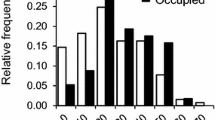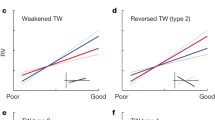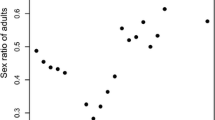Abstract
There is growing evidence that the sex ratios of wild vertebrate populations are determined by mechanisms that are directly influenced by environmental characteristics. The Trivers–Willard (TWH) and extrinsic modification (EMH) hypotheses postulate differing determinants of mammalian offspring sex ratios. TWH states that mothers allocate resources according to their current condition and sex-specific offspring costs. EMH states that environmental forces that affect maternal condition determine offspring sex ratios, independently of maternal tactics of sex-biased allocation. We statistically assessed support for each of these hypotheses using long-term life histories of the allied rock-wallaby, Petrogale assimilis; a continuously breeding, polygynous, weakly dimorphic marsupial. We showed that birth sex ratios were equal and independent of maternal and environmental conditions. However, secondary sex ratios were male-biased under good environmental conditions and for high quality mothers or mothers in good condition. Sex differences in offspring survival contributed to these biases: (1) environmental conditions strongly influenced survival to pouch emergence (in support of EMH) and (2) maternal quality affected survival to the end of maternal care (in support of TWH). Environmental effects on survival were more important than maternal factors over the entire period of maternal care and contributed most to male-biased sex ratios at pouch emergence. In contrast, maternal mass was the best predictor of sex ratios at the end of maternal care—the life history stage where offspring body mass differed between the sexes.




Similar content being viewed by others
References
Akaike H (1973) Information theory as an extension of the maximum likelihood principle. In: Petrov BN, Csaki F (eds) Second International Symposium on Information Theory. Akademiai Kiado, Budapest, pp 267–281
Burnham KP, Anderson DR (2002) Model selection and multimodel inference: a practical information-theoretic approach. Springer-Verlag, New York
Cameron EZ (2004) Facultative adjustment of mammalian sex ratios in support of the Trivers-Willard hypothesis: evidence for a mechanism. Proc R Soc Ser B 271:1723–1728
Cameron EZ, Linklater WL (2000) Individual mares bias investment in sons and daughters in relation to their condition. Anim Behav 60:359–367
Cameron EZ, Linklater WL (2002) Sex bias in studies of sex bias: the value of daughters to mothers in poor condition. Anim Behav 63:F5–F8
Clutton-Brock TH (1991) The evolution of parental care. Princeton University Press, New Jersey
Clutton-Brock TH, Iason GR (1986) Sex ratio variation in mammals. Q Rev Biol 61:339–374
Clutton-Brock TH, Albon SD, Guinness FE (1988) Reproductive success in male and female red deer. In: Clutton-Brock TH (ed) Reproductive success: studies of individual variation in contrasting breeding systems. Chicago University Press, Chicago, pp 325–343
Clutton-Brock TH, Price OF, Albon SD, Jewell PA (1992) Early development and population fluctuations in soay sheep. J Anim Ecol 61:381–396
Cockburn A, Legge S, Double MC (2002) Sex ratios in birds and mammals: can the hypotheses be disentangled? In: Hardy ICW (ed) Sex ratios: concepts and research methods. Cambridge University Press, Cambridge, pp 266–286
Côté SD, Festa-Bianchet M (2001) Birthdate mass and survival in mountain goat kids: effects of maternal characteristics and forage quality. Oecologia 127:230–238
Delaney R (1997) Reproductive ecology of the allied rock-wallaby, Petrogale assimilis. Aust Mammal 19:209–218
Delean S (2007) Longitudinal population demography of the allied rock-wallaby, Petrogale assimilis. PhD thesis, James Cook University, Townsville
Fisher DO (1999) Offspring sex ratio variation in the bridled nailtail wallaby, Onychogalea fraenata. Behav Ecol Sociobiol 45:411–419
Forchhammer MC (2000) Timing of foetal growth spurts can explain sex ratio variation in polygynous mammals. Ecol Lett 3:1–4
Frank SA (1990) Sex allocation theory for birds and mammals. Ann Rev Ecolog Syst 21:13–55
Gaillard J-M, Boutin JM, Delorme D, Van Laere G, Duncan P, Lebreton J-D (1997) Early survival in roe deer: causes and consequences of cohort variation in two contrasted populations. Oecologia 112:502–513
Hardy ICW (2002) Sex ratios: concepts and methods. Cambridge University Press, Cambridge
Hewison AJM, Gaillard J-M (1999) Successful sons or advantaged daughters? The Trivers-Willard model and sex-biased maternal investment in ungulates. Trends Ecol Evol 14:229–236
Hewison AJM, Gaillard J-M, Kjellander P, Toigo C, Liberg O, Delorme D (2005) Big mothers invest more in daughters—reversed sex allocation in a weakly polygynous mammal. Ecol Lett 8:430–437
Horsup A (1996) The behavioural ecology of the allied rock-wallaby, Petrogale assimilis. PhD thesis, James Cook University, Townsville
Horsup A, Marsh H (1992) The diet of the allied rock-wallaby, Petrogale assimilis, in the wet-dry tropics. Wildl Res 19:17–33
Isaac JL, Johnson CN (2005) Terminal reproductive effort in a marsupial. Biol Lett 1:271–275
Isaac JL, Krockenberger AK, Johnson CN (2005) Adaptive sex allocation in relation to life-history in the common brushtail possum, Trichosurus vulpecula. J Anim Ecol 74:552–558
Krackow S (1995) Potential mechanisms for sex ratio adjustment in mammals and birds. Biol Rev 70:225–241
Krackow S (2002) Why parental sex ratio manipulation is rare in higher vertebrates. Ethology 108:1041–1056
Krackow S, Schmidt TA, Elepfandt A (2003) Sexual growth dimorphism affects birth sex ratio in house mice. Proc R Soc Ser B 270:943–947
Krockenberger A (2006) Lactation. In: Armati PJ, Dickman CR, Hume ID (eds) Marsupials. Cambridge University Press, Cambridge, pp 108–136
Kruuk LEB, Clutton-Brock TH, Albon SD, Pemberton JM, Guinness FE (1999) Population density affects sex ratio variation in red deer. Nature 399:459–461
Loison A, Langvatn R, Solberg EJ (1999) Body mass and winter mortality in red deer calves: disentangling sex and climate effects. Ecography 22:20–30
Loison A, Solberg EJ, Yoccoz NG, Langvatn R (2004) Sex differences in the interplay of cohort and mother quality on body mass of red deer calves. Ecology 85:1992–2002
Love OP, Chin EH, Wynne-Edwards KE, Williams TD (2005) Stress hormones: a link between maternal condition and sex-biased reproductive investment. Am Nat 166:751–766
Moses RA, Boutin S, Teferi T (1998) Sex-biased mortality in woodrats occurs in the absence of parental intervention. Anim Behav 55:563–571
Mysterud A, Yoccoz NG, Stenseth NC, Langvatn R (2000) Relationships between sex ratio climate and density in red deer: the importance of spatial scale. J Anim Ecol 69:959–974
Nager RG, Monaghan P, Griffiths R, Houston DC, Dawson R (1999) Experimental demonstration that offspring sex ratio varies with maternal condition. Proc Natl Acad Sci U S A 96:570–573
Post E, Forchhammer MC, Stenseth NC, Langvatn R (1999) Extrinsic modification of vertebrate sex ratios by climatic variation. Am Nat 154:194–204
Schall R (1991) Estimation in generalized linear models with random effects. Biometrika 78:719–727
Sheldon BC, West SA (2004) Maternal dominance, maternal condition, and offspring sex ratio in ungulate mammals. Am Nat 163:40–54
Spencer PBS (1991) Evidence of predation by a feral cat, Felis catus (Carnivora: Felidae) on an isolated rock-wallaby colony in tropical Queensland. Aust Mammal 14:143–144
Spencer PBS (1996) Coping with a naturally fragmented environment: a genetic and ecological study of the allied rock-wallaby, Petrogale assimilis. PhD thesis, James Cook University, Townsville
Spencer PBS, Horsup A, Marsh H (1998) Enhancement of reproductive success through mate choice in a social rock-wallaby, Petrogale assimilis (Macropodidae) as revealed by microsatellite markers. Behav Ecol Sociobiol 43:1–9
Stuart-Dick RI, Higginbottom KB (1989) Strategies of parental investment in Macropodoids. In: Grigg G, Jarman P, Hume I (eds) Kangaroos, wallabies and rat-kangaroos (Volume 2). Surrey Beatty and Sons, Sydney, pp 571–592
Sunnucks P, Taylor AC (1997) Sex of pouch young related to maternal weight in Macropus eugenii and M. parma (Marsupialia: Macropodidae). Aust J Zool 45:573–578
Therneau TM, Grambsch PM (2000) Modeling survival data: extending the Cox model. Springer-Verlag, New York
Trivers RL, Willard DE (1973) Natural selection of parental ability to vary the sex ratio of offspring. Science 179:90–92
Tyndale-Biscoe H, Renfree M (1987) Reproductive physiology of marsupials. Cambridge University Press, Cambridge
Weladji RB, Holand Ø, Steinheim G, Lenvik G (2003) Sex-specific preweaning maternal care in reindeer (Rangifer tarandus t). Behav Ecol Sociobiol 53:308–314
West SA, Sheldon BC (2002) Constraints in the evolution of sex ratio adjustment. Science 295:1685–1688
Acknowledgements
We gratefully acknowledge the contributions of Peter Spencer, Alan Horsup, and Robyn Delaney, and many field volunteers to the collection of the long-term data used for this research. We thank J-M. Gaillard, M. Festa-Bianchet, and an anonymous reviewer for constructive comments. This work was funded by research grants to S. Delean from James Cook University and to H. Marsh from the Queensland Environmental Protection Agency.
Author information
Authors and Affiliations
Corresponding author
Additional information
Communicated by A. Schulte-Hostedde
Electronic supplementary material
Below is the link to the electronic supplementary material.
Table S1
Estimated mean body size and body mass of adult male (n = 62) and female (n = 65) Petrogale assimilis (>3 years of age). Ninety-five percent confidence intervals of body measurements are given in parentheses. Percent sexual size dimorphism = 100 × (log e (male size/female size)). Mean body size and mass were estimated using linear mixed-effects models with sex as the fixed effect. Individual identity was the random effect in the models to account for repeated measurements on each individual. (PDF 52 kb)
Table S2
Rank-order correlations among the maternal and environmental explanatory variables measured at the (1) birth, (2) pouch emergence, and (3) end of weaning life history stages used to explain variation in the sex ratio and survival of Petrogale assimilis offspring at Black Rock. Significance values are given in parentheses and bolded where <0.05. SOI, Southern Oscillation Index. At each stage, population size was correlated with the 6-month mean SOI. Also, maternal mass and condition index were positively correlated; however, this was a threshold relationship; the heaviest mothers were consistently in good condition, yet there was no correlation between mass and condition for mothers weighing less than 3.8 kg. (PDF 69 kb)
Table S3
Table S3-A. Model selection results for sets of candidate models examining variation in the birth sex ratio of Petrogale assimilis offspring associated with TWH, EMH and joint TWH/EMH. df, degrees of freedom; ΔAICc, difference in AICc between model and minimum AICc model; w i , Akaike model weights within candidate sets;%DE, percent deviance explained; overall w i , Akaike model weights across all models. Environmental predictors: R, cumulative 6-month rainfall (log(mm)); and S, mean 6-month Southern Oscillation Index. Maternal predictors: C, body condition; and M, body mass (kg). Additional predictors: P, population size. Random effects: r(ID), mother identity; r(Y), sampling year (both random effects fitted in all models but only listed where the only term(s) in the model). Table S3-B. Model selection results for sets of candidate models examining variation in survival of P. assimilis offspring from birth to pouch emergence associated with TWH, EMH, and joint TWH/EMH. df, degrees of freedom; ΔAICc, difference in AICc between model and minimum AICc model; w i , Akaike model weights within candidate sets; %DE, percent deviance explained; overall w i , Akaike model weights across all models. Environmental predictors: R, cumulative 6-month rainfall (log(mm)); and S, mean 6-month Southern Oscillation Index. Maternal predictors: C, body condition; and M, body mass (kg). Additional predictors: sex, offspring sex; P, population size. Random effects: r(ID), mother identity (fitted in all models but only listed where the only term in the model). Table S3-C. Model selection results for sets of candidate models examining variation in the pouch emergence sex ratio of P. assimilis offspring associated with TWH, EMH, and joint TWH/EMH. df, degrees of freedom; ΔAICc, difference in AICc between model and minimum AICc model; w i , Akaike model weights within candidate sets; %DE, percent deviance explained; overall w i , Akaike model weights across all models. Environmental predictors: R, cumulative 6-month rainfall (log(mm)); and S, mean 6-month Southern Oscillation Index. Maternal predictors: C, body condition; and M, body mass (kg). Additional predictors: P, population size. Random effects: r(ID), mother identity; r(Y), sampling year (both random effects fitted in all models but only listed where the only term(s) in the model). Table S3-D. Model selection results for sets of candidate models examining variation in survival of P. assimilis offspring from pouch emergence to weaning associated with TWH, EMH, and joint TWH/EMH. df, degrees of freedom; ΔAICc, difference in AICc between model and minimum AICc model; w i , Akaike model weights within candidate sets; %DE, percent deviance explained; overall w i , Akaike model weights across all models. Environmental predictors: R, cumulative 6-month rainfall (log(mm)); and S, mean 6-month Southern Oscillation Index. Maternal predictors: C, body condition; and M, body mass (kg). Additional predictors: sex, offspring sex; P, population size. Random effects: r(ID), mother identity (fitted in all models but only listed where the only term in the model). Table S3-E. Model selection results for sets of candidate models examining variation in the weaning sex ratio (i.e., the end of maternal care) of P. assimilis offspring associated with TWH, EMH, and joint TWH/EMH. df, degrees of freedom; ΔAICc, difference in AICc between model and minimum AICc model; w i , Akaike model weights within candidate sets; %DE, percent deviance explained; overall w i , Akaike model weights across all models. Environmental predictors: R, cumulative 6-month rainfall (log(mm)); and S, mean 6-month Southern Oscillation Index. Maternal predictors: C, body condition; and M, body mass (kg). Additional predictors: P, population size. Random effects: r(ID), mother identity; r(Y), sampling year (both random effects fitted in all models but only listed where the only term(s) in the model). Table S3-F. Model selection results for sets of candidate models examining variation in the body mass at weaning (i.e., the end of maternal care) for P. assimilis offspring associated with TWH, EMH, and joint TWH/EMH. df, degrees of freedom; ΔAICc, difference in AICc between model and minimum AICc model; w i , Akaike model weights within candidate sets; %DE, percent deviance explained; overall w i , Akaike model weights across all models. Environmental predictors: R, cumulative 6-month rainfall (log(mm)); and S, mean 6-month Southern Oscillation Index. Maternal predictors: C, body condition; and M, body mass (kg). Additional predictors: sex, offspring sex; A, offspring age; P, population size. Random effects: r(ID), mother identity (fitted in all models but only listed where the only term in the model). (PDF 102 kb)
Table S4
Summary results describing maternal and environmental factors that influenced the sex ratio and survival at each life history stage between birth and weaning for Petrogale assimilis at Black Rock. Accordance with the Trivers–Willard hypothesis (TWH), that predicts offspring sex ratios vary depending on maternal allocation of resources according to sex-specific offspring costs, and/or the extrinsic modification hypothesis (EMH), that predicts environmental forces that affect maternal condition determine offspring sex ratios, are described. ∝ represents the proportion of the specified sex; ↑ represent increases in the specified variable; PEP, permanent pouch emergence; SOI, Southern Oscillation Index; \( \overline X \) sex ratios are probability of male offspring. (PDF 84 kb)
Rights and permissions
About this article
Cite this article
Delean, S., De’ath, G. & Marsh, H. Climate and maternal effects modify sex ratios in a weakly dimorphic marsupial. Behav Ecol Sociobiol 64, 265–277 (2009). https://doi.org/10.1007/s00265-009-0844-0
Received:
Revised:
Accepted:
Published:
Issue Date:
DOI: https://doi.org/10.1007/s00265-009-0844-0




